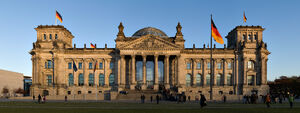
The Reichstag (German for "Imperial Diet") was the parliament of the Holy Roman Empire, the North German Confederation, and of Germany until 1945. The main chamber of the German parliament is now called the Bundestag ("Federal Diet"), but the building in which it meets is still called "Reichstag"
In the 1919 Weimar Republic, the Reichskanzler (chancellor, head of government) was responsible to the Reichstag, which was directly elected by the people, and was a true democratic parliament. From 1930 on, however, the Reichstag was practically circumvented with the use of the extensive powers that were granted to the president under the Emergency Decree in Article 48 of the constitution. After Adolf Hitler was appointed Reichskanzler on January 30, 1933 the process of Gleichschaltung ("marching in step", "synthesis") commenced with the Reichstag Fire Decree (Reichstagsbrandverordnung) and the Enabling Act (Ermächtigungsgesetz), in which the Reichstag formally dispensed of its exclusive legislative powers. From then on it only functioned as a body of acclamation for the actions of the dictatorship.
Reichstag in In the Presence of Mine Enemies
After Germany won the Second World War, the Reichstag continued to merely rubberstamp the Führer's will. However, in 2010, the people of Germany had become disgusted with Nazi tyranny. Newly appointed Führer, Heinz Buckliger, tapped into this disgust and began pushing for reforms. Among these included free and open elections, scheduled for 10 July 2011. Despite an attempted Putsch, the elections went forward, and the reformers won a majority of the seats.
| ||||||||||||||||
